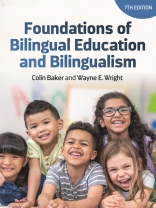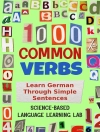The 7th edition of the world’s leading textbook on bilingual education and bilingualism
The seventh edition of this bestselling textbook has been extensively revised and updated to provide a comprehensive and accessible introduction to bilingualism and bilingual education in an everchanging world. Written in a compact and clear style, the book covers all the crucial issues in bilingualism and multilingualism at individual, group and societal levels. Updates to the new edition include:
- Thoroughly updated chapters with over 500 new citations of the latest research.
- Six chapters with new titles to better reflect their updated content.
- A new Chapter 16 on Deaf-Signing People, Bilingualism/Multilingualism and Bilingual Education.
- The latest demographics and other statistical data.
- Recent developments in and limitations of brain imaging research.
- An expanded discussion of key topics including multilingual education, codeswitching, translanguaging, translingualism, biliteracy, multiliteracies, metalinguistic and morphological awareness, superdiversity, raciolinguistics, anti-racist education, critical post-structural sociolinguistics, language variation, motivation, age effects, power, and neoliberal ideologies.
- Recent US policy developments including the Every Student Succeeds Act (ESSA), Seal of Biliteracy, Proposition 58, LOOK Act, Native American Languages Preservation Act, and state English proficiency standards and assessments consortia (WIDA, ELPA21).
- New global examples of research, policy, and practice beyond Europe and North America.
- Technology and language learning on the internet and via mobile apps, and multilingual language use on the internet and in social media.
Students and Instructors will benefit from updated chapter features including:
- New bolded key terms corresponding to a comprehensive glossary
- Recommended readings and online resources
- Discussion questions and study activities
Table of Content
Acknowledgements
Introduction
Chapter 1: Bilingualism and Multilingualism: Definitions and Distinctions
Chapter 2: The Measurement of Bilingualism
Chapter 3: Languages in Society
Chapter 4: Language Endangerment and Revitalization
Chapter 5: The Early Development of Bilingualism
Chapter 6: The Later Development of Bilingualism
Chapter 7: Bilingualism, Cognition and the Brain
Chapter 8: Theories of Bilingualism and the Curriculum
Chapter 9: Historical Introduction to Bilingual Education in the United States
Chapter 10: Types of Education for Bilingual Students
Chapter 11: Education for Bilingualism and Biliteracy
Chapter 12: The Effectiveness of Bilingual Education
Chapter 13: Effective Schools and Classrooms for Bilingual Students
Chapter 14: Literacy, Biliteracy and Multiliteracies for Bilingual and Multilingual Students
Chapter 15: Support and Assessment of Special Needs and Exceptional Bilingual Students
Chapter 16: Deaf-Signing People, Bilingualism/Multilingualism and Bilingual Education
Chapter 17: Bilingualism and Bilingual Education as a Problem, Right and Resource
Chapter 18: Bilingualism and Bilingual Education: Ideology, Identity and Empowerment
Chapter 19: Bilingualism in the Modern World
Glossary
Bibliography
Index
About the author
Wayne E. Wright is Associate Dean for Research, Graduate Programs, and Faculty Development and the Barbara I. Cook Chair of Literacy and Language in the College of Education at Purdue University, USA. He is Co-Editor of the Journal of Language, Identity, and Education, Editor of the Journal of Southeast Asian American Education and Advancement, and Co-Editor of the Bilingual Education and Bilingualism book series.












